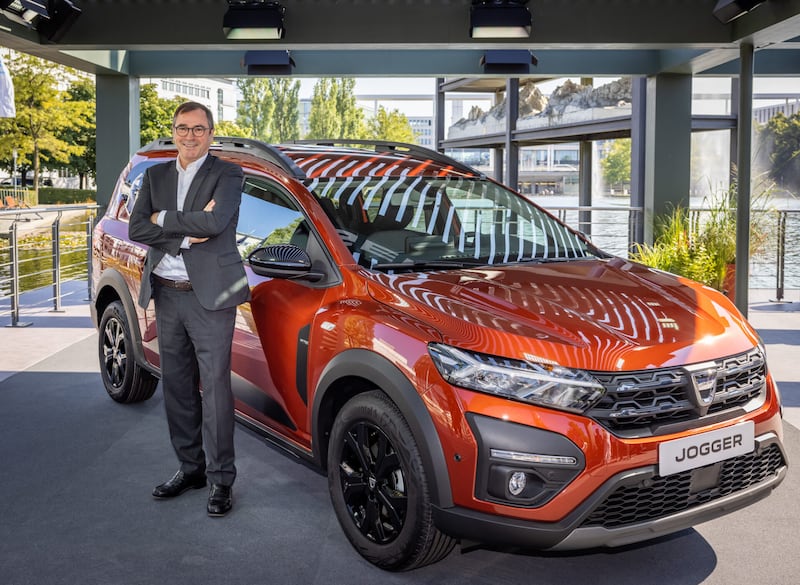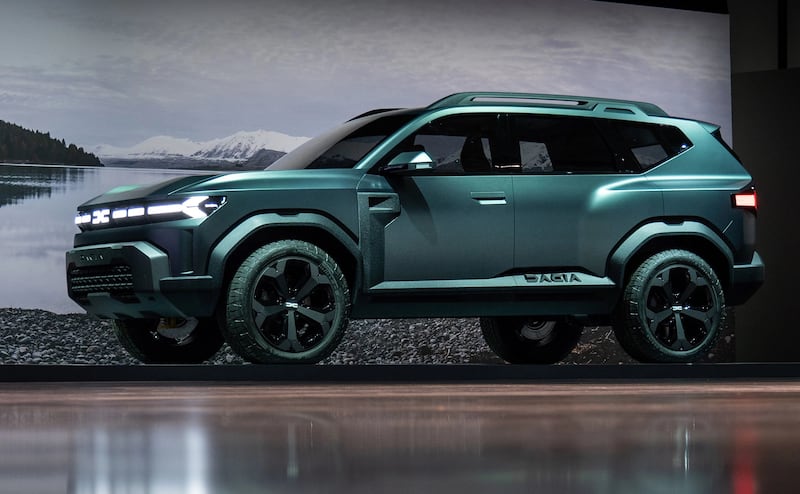Five years ago, the average transaction price for a family-sized car in Europe crossed the €33,000 barrier.
The average price for all cars in Ireland passed that rubicon long ago, and there’s no sign of things slowing down.
Some carmakers – Mercedes, most notably – have come out and simply said that they’re not going to chase volume and affordable sales anymore, and will instead focus on high-margin, high-cost luxury models instead.
There seems little respite from this tide of increasing motoring costs. With electric cars remaining stubbornly more costly than their combustion-engined counterparts, and the expected costs of re-engineering petrol models for the incoming Euro7 emissions regulations, how can anyone still sell a car that an average car buyer might consider affordable?
READ MORE
Well, Dacia reckons it can, and reckons that it might just be uniquely placed to do so. The Romanian brand – which originally grew out of the Romania national aircraft maker, and which only made its first car in 1968, based on a Renault 8 – has been owned by Renault since 1999. Since 2004, with the first, simple, Logan saloon, it has been making affordable, occasionally downright cheap (in both senses of the word) cars which have proven a huge hit with European and Irish buyers.
In fact, Dacia is one of the few brands that sells more cars to private buyers – some 80 per cent of its sales – than to discount-hungry company car fleet operators. In Ireland, Dacia has, thanks to impressive sales figures both for its Duster crossover and Sandero supermini, muscled its way into the top-10 selling brands, actually outselling its masters at Renault by a margin of more than 1,000 cars so far this year.

“My job, our quest, is to get rid of the low-cost kind of feeling about Dacia, and instead make it about being the best value-for-money brand,” Denis Le Vot tells The Irish Times. Le Vot, a 30-year veteran of the Renault Group, is Dacia’s chief executive and we’re chatting in a sweltering meeting room near Dacia’s home factory, just outside Bucharest.
“The old image of the brand is of people smoking on the production line, and painting the cars by hand, with brushes” says Le Vot, hands and arms animating his words. “That’s not the case anymore.”
Dacia has, so far, successfully executed a move slightly upmarket from where it once was. When it first arrived in Ireland in 2014, first with the Duster and then with the Sandero, its cabins were cheap enough to make you wince, with sharp edges to the plastic panels which could literally leave you with injuries. Those days are gone, but the prices haven’t gone up all that much, although Le Vot admits that the days of truly cheap cars may well be over.
“We no longer make a €9,000 Sandero, because we can’t,” he says. “The cost of steel, of raw materials, have all gone like this” he said, jutting his hand and forearm out at a steep upward angle.
“Maybe, in not too long, the days of the €15,000 car will be gone too, because you’re going to see a lot of extra cost to meet Euro7 emissions, if the rules come into force as they are written now.”
That all sounds rather gloomy, but Le Vot is ebullient, confident that no matter how much the average cost of cars increases, Dacia will be offering buyers a more affordable alternative.
“It’s because we’re part of the Renault Group. Without Renault, Dacia could not exist. And so we have a cupboard of parts, of components, that we can go to, and pick up and use, and much of the cost of these parts has already been amortised. So, you combine that with factories that are running at full capacity – we already run three shifts here in Romania and in Morocco – and that is how we offer such good prices.”
It’s about more than that, though. Le Vot says that the affordability of a Dacia is baked in from the start. “We do not take a Renault and then pull things out of it to make it cheap” he says. “Instead, we say how do we do more with less. So we use the same parts as a Renault – the CMF-B platform, for example – and we go to the cupboard and we say we need this and this, but not this. So from the start we are putting in only what is essential.”
[ Dacia’s new Sandero hit with two-star safety ratingOpens in new window ]
This essentialist approach has led to controversy, especially when it comes to safety. Dacia’s cars – the seven-seat Jogger and the compact Sandero hatchback especially – have come in for heavy criticism from the independent crash test experts at Euro NCAP, which awarded both cars lowly safety ratings.
Dacia’s head of product, Lionel Jaillet, defends Dacia’s approach to The Irish Times, saying: “The pressures of regulation mean that carmakers are putting more and more ADAS systems into their cars, and many of the things are not valued by the customer. All this adds cost, so at some point you’re putting systems into the car, but people can no longer afford the car. So this is a little bit strange.”
We put it to Jaillet that letting customers decide how safe their cars ought might to be less than satisfactory, especially as traditionally car buyers tended to pick options they could see – air conditioning or a sunroof, in place of ABS or stability control when those were still optional extras – but he remains convinced that Dacia is offering buyers fundamentally safe cars.
“We are here to comply with regulations, of course. If you look at the Sandero, and look at the passive safety side, it is a four-star car. But at the end we get only two stars because we are not ticking the electronic safety boxes, but we do fit the automated emergency braking – why? Because the customers are asking for it. So it does not mean that our cars are not safe. They are safe, and each Dacia that comes on to the market is safer than the last one.”
Both Le Vot and Jaillet say that they are committed to making their cars as safe as possible, but that additional safety features, such as lane-keeping steering, end up being redundant as: “It annoys the customer. They end up turning it off.”
[ Dacia Jogger: New seven-seat MPV seems like a safe betOpens in new window ]
Electrification is another rubicon for Dacia to cross. The brand already has an EV on sale in Europe – the Spring, with its 250km range and, depending on taxes, €10,000 price tag – and that will come to Ireland in 2025 when the model gets a major mid-life update. However, Le Vot says that Dacia is in no rush to go electric.
“You look at Renault, and Renault is going all-electric. This is the plan and you have already seen some of the cars, the Megane, the Renault 5, the new Renault 4,″ Le Vot tells says.
“Because of that, and because we are part of the Renault Group, it means that Dacia can benefit from Renault going to zero emissions. As well as that, we are introducing electrification – we already have the hybrid Jogger on sale, and the Spring – and that will increase. Plus, we continue with our LPG development, which, okay, only saves 10 per cent of emissions, but 10 per cent is a help, and our cars are lighter and more efficient than the competition.
“Look at Jogger – here is a seven-seat car which weighs 1,200kg. That’s 300kg less than the opposition, and so we only need a little 1.0-litre, three-cylinder engine to give it good performance. Our moment of electrification will come with the next-generation Sandero, which will arrive in 2027 and which has to live past 2034. But other carmakers are all looking for cars which will do 500km or 600km, and which will charge quickly. I can tell you that we will not do this. We will look at shorter ranges and slower charging. Why? So that we can achieve the price point for our customers.”
Le Vot also says that Dacia will not follow its fellow ex-communist carmaker Skoda in a march upmarket. “Definitely not. What we are seeing now is that when Dacia started, a lot of our buyers were coming from the second-hand market, buying their first new car. Now what we see is that people are coming to our brand from, as I call it, ‘upstairs’.
“They have bought a car for a certain price before, and now they are finding that maybe it’s €5,000 or €10,000 more to upgrade. And so the see Dacia and they see the value we offer, and they come to us. If you walk around the city here and look for the best price for a small hatchback, or for a seven-seater, you will only see the Sandero and the Jogger. And this will not change.”
Dacia will change a little, and it will move fractionally upmarket but Le Vot says it won’t sell cars costing more than €40,000 and it won’t change the brand to an agency sales model. “Already we have set prices, no haggling, and we sell the brand under one roof with Renault. Sixty per cent of our customers are conquest sales, coming from other brands, and of our buyers 80 per cent stay with Dacia, and 15 per cent move on to buy a Renault, so it’s working perfectly. We have experimented with online sales – we’ve done it in the UK where you can buy the complete car with your credit card, and click and have it delivered. And how many people did this? About 28 people. I think people still want to go to the dealer and see the car before they buy.”
Currently, Dacia’s three core models – the Sandero (and its Stepway 4x4-lookalike version), the Duster and the Jogger – are all technically “B-segment” cars, based on the architecture of the Renault Clio.

Next year, Dacia will start to break into the larger, more lucrative, “C-segment”. Still using the small-car “CMF-B” platform that underpins the Sandero, Dacia will stretch the basics of this platform to its dimensional limits, creating a new Duster (due next year, which will be available as a hybrid for the first time) and in 2025 a new larger crossover, based on the Bigster concept car which will be a cut-price rival to the likes of the (distantly-related) Nissan Qashqai. Beyond that, there will be two further C-segment models, of which we currently know little.
Jaillet affected a coy expression when we asked if Dacia might do a traditional five-door hatchback to fill the gap left by the departing Ford Focus, saying only: “We want to be an ‘outdoor’ brand, we want to have a flavour of that in all of our models. That does not mean we will have only SUVs and crossovers. There are other ways of doing the C-segment.”
To do that, Dacia will almost certainly need more factory space. We visited the Mioveni plant outside Bucharest – closer to a robotised operating theatre than a dirty, grimy car factory – which is working flat out to make the Duster and Jogger, while the Sandero and Stepway are made in Morocco. Already the brand is finding close to 600,000 customers each year, and Le Vot reckons that it will hit one million, although he refused to predict when that might happen: “The market will decide.”




















